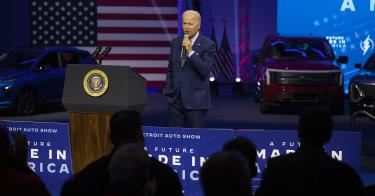President Joe Biden’s Environmental Protection Agency has announced an aggressive new auto tailpipe emissions rule that would ban most new cars and trucks that don’t run on batteries. In exchange for reductions in CO2 and other tailpipe emissions, the EPA plans to take away Americans’ freedom to choose our cars.
It also touts the benefits of supposedly lower consumer costs stemming from the regulation, which means the federal government—the same entity that saddled us with over $31 trillion in national debt—thinks it knows better than us how to be responsible with money.
The Biden administration is openly pushing that, by 2032, the share of new gasoline vehicles sold versus electric vehicles should be just one in three. This type of central planning has no place in a free country, and the federal government has no right to intervene in such an aggressive way in our transportation choices.
The White House press release referred to Biden as a “self-proclaimed car guy,” as if that should make us feel any better about the fact that the president is trying to dictate what types of cars we can drive.
Is there anything less American than taking away gasoline-powered cars? Being on the open road with a full tank of gas provides a very real sense of freedom—taking that away and replacing it with higher price tags and shorter ranges would be cruel. Biden and his EPA might as well try to ban baseball and apple pie. (Note: In case anyone from the Biden administration is reading this, that was rhetorical—please don’t try to ban anything else).
The EPA rule means we can only go where the electric car commissars want us to go. Charging station networks will have to be planned and subsidized, and it’s easy to imagine subsidies favoring “helpful” cities and states over those that oppose EPA overreach. We aren’t quite in Sino-Soviet railway territory yet, but we are inching closer to the central planner’s dream of control over the transportation sector. It doesn’t feel like a stretch to say the old Soviet Union and Communist China would approve of this plan.
The EPA also claims the rule will not harm electric grid reliability, but make sure to read the fine print. EPA says the increase in electricity demand due to an electric vehicle mandate “is not expected to adversely affect grid reliability.” EPA goes on to explain there will be no grid reliability issues if the government can dictate what time of day you can charge your electric vehicle (pages 377-379). Once again, the plan is to have Americans serve our “transitioning” electric grid, when in fact the grid should be serving us.
The tailpipe rule has a dollars-and-cents effect, too. For most Americans, this EPA rule means a new car will be significantly more expensive, less practical (because of the shorter range of batteries, the lack of charging stations, etc.), or simply out of financial reach. Even though new car prices are currently going up across the board, the top-selling gasoline-powered vehicles are far more affordable than their all-electric alternatives.
Ford F-series trucks have been bestsellers for years. A gasoline-powered 2023 model Ford F-150 truck now has a starting price of $35,680, while the electric F-150 Lightning starts at $61,869. The same is true for bestselling cars—the 2023 Toyota Camry starts at $27,315, while the electric Tesla Model 3 starts at $43,630.
At the Model 3’s price point, you could upgrade to a luxury gasoline vehicle with the 2023 Audi A4 (starting at $41,395). Or, to match the Camry’s price point, you could opt for the absolute lowest-cost electric vehicle with the 2023 Chevrolet Bolt, which starts at $27,495 but is a mini hatchback.
Most American families simply cannot afford to pay the luxury premium for an electric car or truck and are unwilling to make the tradeoff on size and performance with an EV.
So, what’s the solution? In the near term, it would be nice to see Congress limit the EPA’s budget. There’s also the Congressional Review Act where Congress can stop or repeal a federal agency rule. The act was used to push back on a recent overreach by Biden’s Department of Labor. Unfortunately, the president vetoed it, but that doesn’t mean it shouldn’t be tried on the EPA.
Looking further ahead, congressional reform of the Clean Air Act may be necessary. But the most effective tool could be for the public to comment on the proposed rule and tell EPA to stand down.
Although we have seen this trick before, notably when Barack Obama gloated about his plan to make electricity prices “necessarily skyrocket” to try to end America’s use of fossil fuels, Biden’s EPA seems to have even fewer guardrails.
Let’s hope the public pushes back on Biden’s plans to remake the American auto industry and his attempts to take away Americans’ freedom to choose the vehicles we drive. And let’s ensure that the EPA’s proposal hits some major legal roadblocks in Congress and the courts.
This piece originally appeared in The Daily Signal



